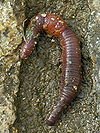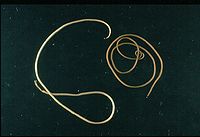Worm
- For other uses, see Worm (disambiguation).

A worm is a common name given to a diverse group of invertebrate animals that have a long, soft body and no legs. There are hundreds of thousands of species of worms, 2,700 of these are earthworms. Animals which are commonly called worms include species of annelids, insects (their immature larva stage), and flatworms. Many marine and freshwater species, which are usually seen only by professional biologists, are recognized as "worms".
Distribution and habitat

Worms live in almost all parts of the world including marine, freshwater, and terrestrial habitats. Some worms living in the ground help to condition the soil (e.g., annelids, aschelminths). Many thrive as parasites of plants (e.g., aschelminths) and animals, including humans (e.g., platyhelminths, aschelminths). Several other worms may be free-living, or nonparasitic. There are worms that live in freshwater, seawater, and even on the seashore. Ecologically, worms form an important link in the food chains in virtually all the ecosystems of the world.
Classification
In everyday language, the term worm is also applied to various other living forms such as larvae, insects, centipedes, shipworms (teredo worms), or even some vertebrates (creatures with a backbone) such as blindworms and caecilians. Worms can be divided into several groups,
- The first of these includes the flatworms. This phylum is called Platyhelminthes. They have a flat, ribbon- or leaf-shaped body with a pair of eyes at the front. Some are parasites.
- The second group contains the threadworms, roundworms, and hookworms. This phylum is called Nemotoda. Threadworms may be microscopic, such as the vinegar eelworm, or more than 1 meter (3 feet) long. They are found in damp earth, moss, decaying substances, fresh water, or salt water. Some roundworms are also parasites. The Guinea worm, for example, gets under the skin of the feet and legs of people living in tropical countries.
- The third group consists of the segmented worms, with bodies divided into segments, or rings. This phylum is called Annelida. Among these are the earthworms and the bristle worms of the sea.
There are hundreds of thousands of species that live in a wide variety of habitats other than soil. Over time this broad definition narrowed to the modern definition, although this still includes several different animal groups. Phyla that include worms include:

- Acanthocephala (spiny-headed worms)
- Annelida (segmented worms)
- Chaetognatha (arrow worms)
- Gnathostomulid (jaw worms)
- Hemichordata (acorn/tongue worms)
- Nematoda (roundworms)
- Nematomorpha (horsehair worms)
- Nemertea (ribbonworms)
- Onychophora (velvet worms)
- Phoronida (horseshoe worms)
- Platyhelminthes (flatworms)
- Priapulida (phallus worms)
- Sipuncula (peanut worms)
The most common worm is the earthworm, a member of phylum Annelida. Earthworms in general have been around for 120 million years, evolving during the time of the dinosaurs. They enrich and aerate the soil; Charles Darwin found that worms turn over the top six inches (15 cm) of topsoil every 20 years. They lack a brain but have nerve centers (called ganglia); they also lack eyes but can sense light with photoreceptors. Worms are hermaphrodites (both sexes in one animal) but can cross fertilize.
Other invertebrate groups may be called worms, especially colloquially. In particular, many unrelated insect larvae are called "worms", such as the railroad worm, woodworm, glowworm, bloodworm, inchworm, mealworm, or silkworm.
Worms may also be called helminths, particularly in medical terminology when referring to parasitic worms, especially the Nematoda (roundworms) and Cestoda (tapeworms). Hence "helminthology" is the study of parasitic worms. When an animal, such as a dog, is said to "have worms", it means that it is infested with parasitic worms, typically roundworms or tapeworms.
"Ringworm" is not a worm at all, but a skin fungus.
Characteristics
Worms usually have a cylindrical, flattened, or leaf-like body shape and are often without any true limbs or appendages. Instead, they may have bristles or fins that help them move. Many worms have sense organs that can detect environmental change. A few may even have light-sensing organs. Worms vary in size from less than 1 mm (0.04 inch) in certain aschelminths to more than 30 m (100 feet) in certain ribbon worms.
Some worms reproduce sexually. Hermaphroditism, the condition in which a single individual possesses both male and female reproductive parts, is common in many groups of worms. Asexual reproduction, whereby new individuals develop from the body cells of another, also occurs in some worms.
Worm species differ in their abilities to move about on their own. Many species have bodies with no major muscles, and cannot move on their own — they must be moved by forces or other animals in their environment. Many other species have bodies with major muscles and can move on their own; they are a type of muscular hydrostat. Many species of worms are decomposers; they break down dead plants and animals to return nutrients to the soil.
Image in Art
Worms are used as a metaphor of putrefaction (The Battleship Potemkin), death taking over life and death itself, an image of hell. There exists a mythological image of a never dying worm who is eternally eating dead people (Ligeia).
Credits
New World Encyclopedia writers and editors rewrote and completed the Wikipedia article in accordance with New World Encyclopedia standards. This article abides by terms of the Creative Commons CC-by-sa 3.0 License (CC-by-sa), which may be used and disseminated with proper attribution. Credit is due under the terms of this license that can reference both the New World Encyclopedia contributors and the selfless volunteer contributors of the Wikimedia Foundation. To cite this article click here for a list of acceptable citing formats.The history of earlier contributions by wikipedians is accessible to researchers here:
The history of this article since it was imported to New World Encyclopedia:
Note: Some restrictions may apply to use of individual images which are separately licensed.

